In the fast-paced world of manufacturing, change is constant. New technology, new products, global trends, and evolving customer demands require factories to be agile and adaptable.
However, managing change can be challenging when different teams operate with disconnected systems on a tight timeline. When teams make decisions that impact one another without communicating or planning in advance, projects can suffer. In fact, most factory planning projects do not meet time and cost goals: 60% are over time and 72% are over budget.
But there are ways to circumvent this as global manufacturing trends change. In this article, we will explore the concept of Integrated Factory Modeling. It is an approach that integrates Building Information Modeling (BIM) and digital factory systems into a single source of truth.
Let's dive into the potential of what Integrated Factory Modeling can do for your manufacturing operations and drive greater efficiency.
The Evolving Nature of Manufacturing Operations
As we move forward in the digital age, a factory's ability to adapt not only determines its competitiveness, but also its potential to lead in the global market.
The challenges posed by fluctuations in global supply and the long-term impacts of COVID-19 on shipping and supply chains have amplified the complexities of manufacturing processes.
While the number of U.S. manufacturing plants has fallen by roughly 25% since 1997, there has been a recent resurgence in recent years. The real challenge is that an increased import dependence has left key U.S. manufacturing supply chains exposed to greater global risks. U.S. manufacturing companies that successfully restructure their supply chains to boost local production will have to make changes on many fronts.
To address this, manufacturers have increased their digital investment over the past few years and accelerated the adoption of technology. Many manufacturers are trying out new (even smart) technologies. One in five manufacturers is already experimenting with new technical solutions.
This is forcing US manufacturers to bring more of their manufacturing capabilities back to the United States. However, one study found that recent factory planning projects have reported cost increases and time delays due to non-transparent information between different planners.
The Power of Integrated Factory Modeling:
One of the ways that we can overcome these obstacles in the United States is automating our way out of challenges. Manufacturers already have mountains of data that they're utilizing to digitize their manufacturing process. But now that manufacturing is resurging, that means companies need to open more facilities.
How can companies connect those new factories or repurpose old facilities for this new work that's coming in? That’s where BIM and integrated factory modeling work together to get your lines up and running as fast as possible.
“Manufacturers need to be nimble enough to quickly make changes on the manufacturing line when there are issues with a product. With Integrated Factory Modeling, teams can easily see what is happening on the manufacturing floor and unify their operations for a better, more agile manufacturing facility.” - Jeremy Stefanek, Director of Sales – Customer Success and CAD Solutions at Hagerman & Company
Integrated Factory Modeling is the integration of BIM and digital factory systems into a unified platform. The benefits of this integrated approach includes:
- Eliminating human-prone errors during factory planning
- Enhancing organization-wide collaboration and transparency
- Providing a single source of truth
Streamline Manufacturing Operations
By creating a unified digital representation of the factory, Integrated Factory Modeling enables these diverse teams to visualize the same information in real time, facilitating coordination and ensuring that changes made by one team are instantly reflected to all parties.
Mitigate Risks and Boost Accuracy
In light of the heightened supply chain risks associated with global manufacturing, reducing risks is critical for manufacturing companies. One method to prevent risk is boosting the accuracy of internal file or data sharing.
Within the realm of Integrated Factory Modeling, accurate file sharing becomes an invaluable component. It maintains an up-to-date and accurate model of the manufacturing floor.
Errors or inconsistencies in file sharing can lead to serious complications, causing potential delays, cost overruns, and product quality issues. To mitigate this, it is essential to establish standardized file formats and protocols.
Implementing an automated synchronization process can further reduce errors by ensuring that changes made by one team are immediately visible to all relevant parties. By integrating these strategies within the Integrated Factory Modeling framework, factories can enhance collaboration, increase operational efficiency, and deliver superior products.
However, knowing how to use Integrated Factory Modeling and share files to design your factory might not be intuitive for new or current employees. By leveraging training resources from industry experts, such as Hagerman & Company, manufacturers can speed up their internal process needs.
But don’t just take our word for it – hear from someone who recently partnered with our team.
“[It was a] Great project and everything was seamlessly organized. The team helped with all of our questions and we wrapped the project in record time. Support experience is always terrific. Every engineer is hyper knowledgeable and answers emails within 2 hours it seems. We always love working with Hagerman on projects!” - Sean Gray
Conclusion: The Future of Manufacturing Operations is Digital
The world is changing fast, and factories must be able to evolve quickly. Integrated factory modeling helps project contributors plan for it. And with a great plan in place, improving operational efficiency, reducing risk, and achieving growth is inevitable.
By integrating BIM and digital factory systems, factories can create a unified platform that empowers teams to work together. This enables As global manufacturing trends continue to change, embracing this integrated approach can position U.S. factories at the forefront of innovation.
Interested in learning more about how you can use integrated factory modeling to address your manufacturing needs? Industry leaders like Porsche, Technica International, and Blue Projects are doing this through integrated factory modeling. Read our eBook to learn more about their success stories.





Comments